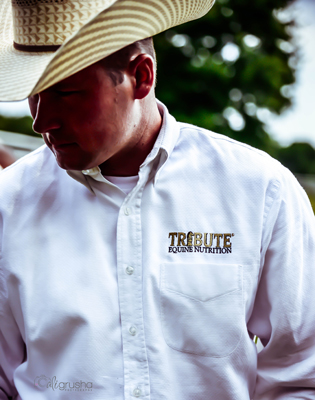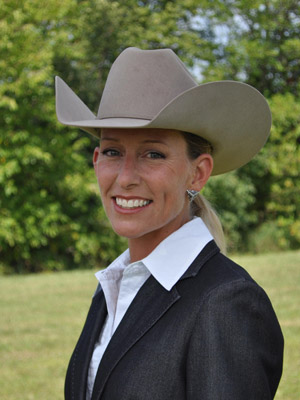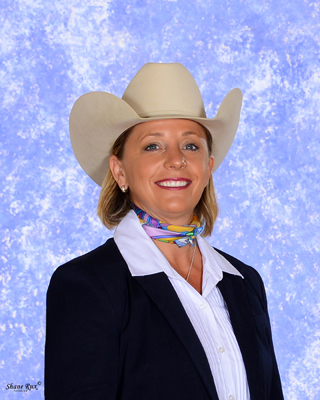 Standing in the middle of the arena watching glimpses of horses go by and having only minutes to place an entire class of horses is harder than it may seem. In fact, what the judges see may be an entirely different view from what spectators see from the rail. Newly approved American Quarter Horse Association judges share their perspectives on how different a judge’s view can be and provide insight into what they have learned about how to better exhibit their own horses.
Standing in the middle of the arena watching glimpses of horses go by and having only minutes to place an entire class of horses is harder than it may seem. In fact, what the judges see may be an entirely different view from what spectators see from the rail. Newly approved American Quarter Horse Association judges share their perspectives on how different a judge’s view can be and provide insight into what they have learned about how to better exhibit their own horses.
Jonathan Meilleur of Hamburg, Pennsylvania first received his American Quarter Horse Association judge’s card in 2013 and is now in the process of testing for his National Snaffle Bit Association card.
Moving to the United States from Canada when he was 18, Meilleur was fortunate to work with some of the country’s finest horse trainers including Gretchen Mathes, Gene Spagnola, Garry and Tami McAllister and Jeff Long.
Since 2010 he has operated Meilleur Performance Horses with his wife, Casey, and daughter, Addison, where he has ridden and coached many top horses in a variety of disciplines.
He also enjoys giving clinics in the United States as well as Canada.
Meilleur says he believes becoming a judge has significantly changed his perspective as an exhibitor.
“I notice things now that I never noticed before and I am more acutely aware of the importance of putting your best foot forward,” Meilleur says. “Presentation and preparation are two key elements in gaining the advantage while showing.”
While Meilleur does not think he has necessarily demonstrated his horses differently since becoming a judge, he does believe he has become increasingly aware of the importance of entering the show arena totally prepared.
“There was a time in my career where I would school if my horse was not performing as I wanted,” Meilleur says.
“Now I try my best to not put myself or my horse in that situation. I have also become more critical of my horses and have raised my expectations of both myself and my clients. I have learned from judging that what I felt was good is now not good enough. I also love sharing ideas, methods, thoughts, philosophies and general horse knowledge with my fellow judges and always come home a little more enthused and enlightened.”
Meilleur has found that his first look at each exhibitor is very important and should grab his attention. He best advises exhibitors to pay attention to details because they all matter.
“I have learned that you need to show until the end,” Meilleur says. “Sometimes when you think your horse has either made a mistake or isn’t having the best ride, you don’t realize that the judge doesn’t know that. Therefore, show like it is the best it can be and never give up!”
 A professional horse trainer for 17 years, Jennifer Leckey of Richmond, Indiana first received her AQHA judge’s card in 2010. In addition, she holds a NSBA judge’s card. She and husband, Mitch have trained, shown and coached multiple AQHA World, Quarter Horse Congress, NSBA World and major futurity champions. Leckey says her perspective as an exhibitor has changed, since getting her card. She has a new view on showing that has made a difference in the way both she and Mitch present their horses in the show pen.
A professional horse trainer for 17 years, Jennifer Leckey of Richmond, Indiana first received her AQHA judge’s card in 2010. In addition, she holds a NSBA judge’s card. She and husband, Mitch have trained, shown and coached multiple AQHA World, Quarter Horse Congress, NSBA World and major futurity champions. Leckey says her perspective as an exhibitor has changed, since getting her card. She has a new view on showing that has made a difference in the way both she and Mitch present their horses in the show pen.
“Standing in the middle, I now realize what judges really see,” Leckey says. “It has made me sharpen my skills and be more aware of trends and rules within the association. It has also helped me a lot as a coach because I have been able to pass new information to my clients as far as skills they should possess and pet peeves other judges may have.”
Leckey explains that when she first started judging Hunter Under Saddle classes she often had a hard time seeing all the horses. She would find herself trying to “search for horses” but the more she judged, the more she realized it is really the exhibitors’ job to present their horses to her.
“As a showman, I now realize the importance of getting a good spot to present my horse and making sure I get seen by the judges,” Leckey says.
She advises fellow exhibitors to not over school when showing because even when exhibitors are warming up for a class while the previous one is being placed, the judges are still watching and see what’s going on. To her, it’s just part of the overall presentation that exhibitors present to the judge, which often begins even before the horses are technically being judged.
Also as part of the overall presentation, she stresses the importance of having your horse in good condition. As a judge, she finds it very offensive if a horse is thin or marked up.
She thinks exhibitors should consider that judges often only get to see “little glimpses” of each horse so a good first impression is key. In addition, she likes to see exhibitors present their horse to the best of their ability and is not as picky as some judges as to the amount of time it takes for gait departures.
“A first impression of confidence is very important,” Leckey says. “A presentation that is confident just makes it all look easier.”
When judging, Leckey finds the top end horses in the class the easiest to pick out and find as well as the bottom end. The middle placings in the class though she finds can be the hardest to determine.
Although Leckey still often hears people complaining about judges at shows, she encourages exhibitors to consider that judges are just people too and are doing the best job they know how to make it all work.
“Being a judge has really changed my perspective because everything looks so different,” Leckey says. “As a judge, you only see certain things and you learn to respect a lot of opinions when you are the exhibitor.”
 With 36 years of experience in the Quarter Horse industry, Nancy Alto-Renfro of Finley, California earned her AQHA judge’s card in 2012. With a highly successful amateur career, Renfro won the prestigious All-Around Amateur Award at the AQHA World Show three times. Becoming a professional 10 years ago, Renfro has coached and shown multiple AQHA and NSBA World Champions in a variety of events.
With 36 years of experience in the Quarter Horse industry, Nancy Alto-Renfro of Finley, California earned her AQHA judge’s card in 2012. With a highly successful amateur career, Renfro won the prestigious All-Around Amateur Award at the AQHA World Show three times. Becoming a professional 10 years ago, Renfro has coached and shown multiple AQHA and NSBA World Champions in a variety of events.
Renfro has gained a whole new perspective through judging and explains just how differently horses can look standing from the middle of the arena versus standing on an end or even from up above the horses in the stands.
“Your perspective is definitely different from the middle,” Renfro says. “The time say four to five seconds per horse is so much shorter than that of someone outside watching a horse down the whole rail.”
Often Renfro sees non-pro exhibitors making mistakes at the end or the side of the arena that their trainers are on because they are being coached to change something. She encourages exhibitors to remember that judges can hear and see trainers coaching and to be aware of where the judge is looking because fixing can change the way the horse looks.
“Try to be consistent when you are going around the rail,” Renfro says.
Since she has been judging, Renfro has become more confident in getting off the rail in Western Pleasure classes when she exhibits them. She used to feel even if she was on a bigger horse like on a 16.2-hand horse who naturally has a bigger stride than say a 14.3 hand horse that she would need to stay stacked up on the rail behind the smaller horse. She realizes from judging to show her horses at the speed at which they best look at even if it that means coming off the rail some.
In Western Pleasure classes especially, she sees exhibitors coming into the arena with their horses real “backed off.” She advises exhibitors to come into the arena trying to show their horses at their best from the start.
“I encourage exhibitors to come into the arena ready to show,” Renfro says. “Be prompt and aggressive when the gaits are called and let me see what you have. Don’t be afraid to show your horse.”
 Keith Miller of Reidsville, North Carolina received his AQHA judge’s card in May. Recently, he also was approved for a National Snaffle Bit Association and an American Paint Horse Association judge’s card. He and wife, Sydney, operate Miller Quarter Horses where they have produced AQHA World and Reserve World Champions, NSBA World Champions, AQHA High Point Champions and multiple top-ten finishers at the major shows in an array of events.
Keith Miller of Reidsville, North Carolina received his AQHA judge’s card in May. Recently, he also was approved for a National Snaffle Bit Association and an American Paint Horse Association judge’s card. He and wife, Sydney, operate Miller Quarter Horses where they have produced AQHA World and Reserve World Champions, NSBA World Champions, AQHA High Point Champions and multiple top-ten finishers at the major shows in an array of events.
Miller says he believes judges have a very different perspective than that of exhibitors in the class or from those watching on the rail.
“I’ve watched classes from the rail and made quick decisions based on what I’ve seen while watching a pen full of horses,” Miller says. “When you are judging it isn’t quite as easy as that. You’re constantly critiquing each horse’s performance and their faults and making notations. Judges want to get their placings correct, even the ones at the bottom of the card. Most judges know how hard all the exhibitors have worked and realize there is a difference between a fifth and eighth place.”
Since he has been judging, Miller has learned not to sweat the small stuff when he is showing his own horses.
“Sometimes you think that everything has to be so perfect or feel perfect,” Miller says. “Most of the time the people that continue to show and don’t tell on themselves usually end up doing extremely well. It usually feels a lot worse than it looks.”
In Hunter Under Saddle classes especially, Miller sees exhibitors commonly ending up in groups which makes it extremely difficult for the judge to see the horse and the exhibitor’s number.
“I understand why people end up circling the judge but it doesn’t do your horse’s movement justice,” Miller says. “I would like to see more exhibitors use their arena to get by themselves and then closer to the rail. Your horse’s legs will look slower when they are farther away from the judge and the horse will look more relaxed and pleasant when it isn’t crowded with all the other horses.”
As for Western Pleasure classes, Miller commonly sees exhibitors not walking their horses. He really likes to reward exhibitors who pick up the called-for gate promptly.
“I especially find myself getting irritated when I’m standing in a big arena with five horses and nobody will walk or jog off,” Miller says.
So, what is the most important thing that he has learned about showing since he has become a judge?
“Good sportsmanship is definitely the biggest thing!” Miller says. “No one likes a poor sport and maintain your composure when things don’t necessarily go your way.”
He thinks most judges realize that horses are going to mess up and that some horses will need to be schooled appropriately.
“I used to think that judges were always judging my ability to produce a product and if it was sub par they would look negatively at me,” Miller says. “The reality is judges really do root for people. Judges like watching great patterns and great goes and are hoping that everyone gets their pattern correct.”



You must be logged in to post a comment Login